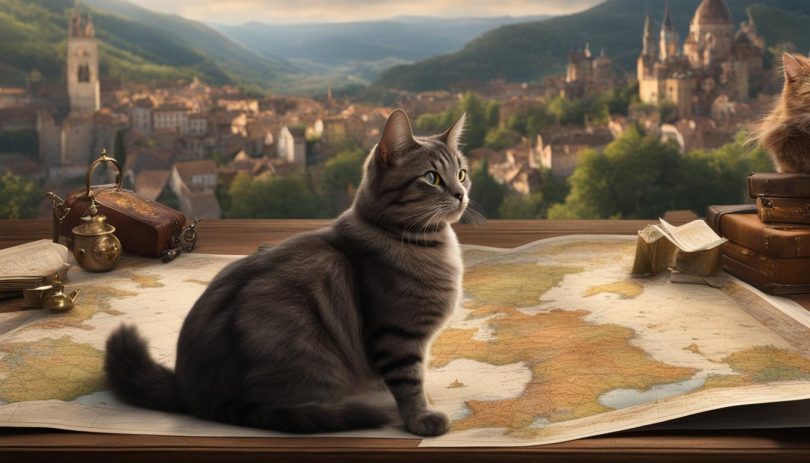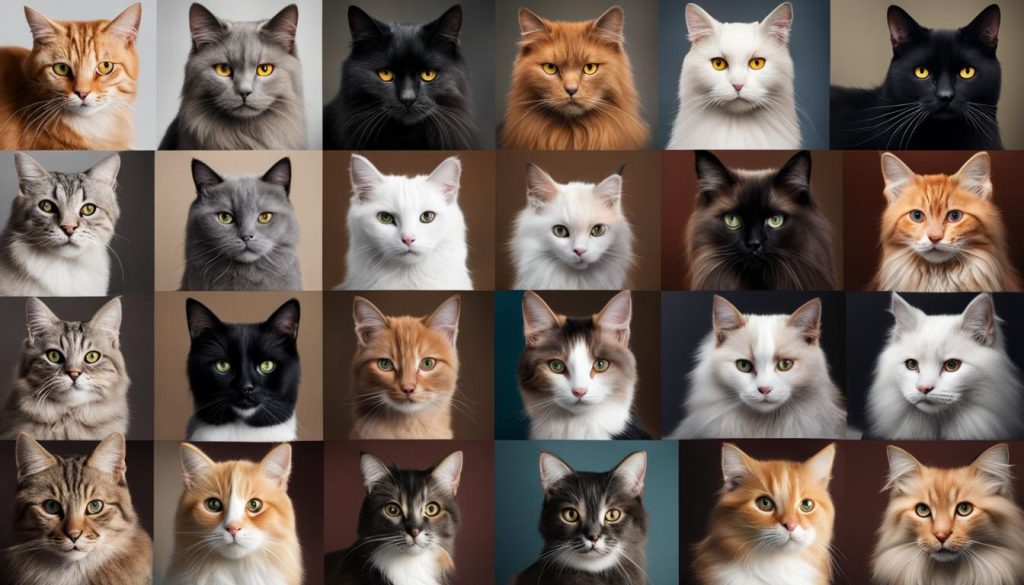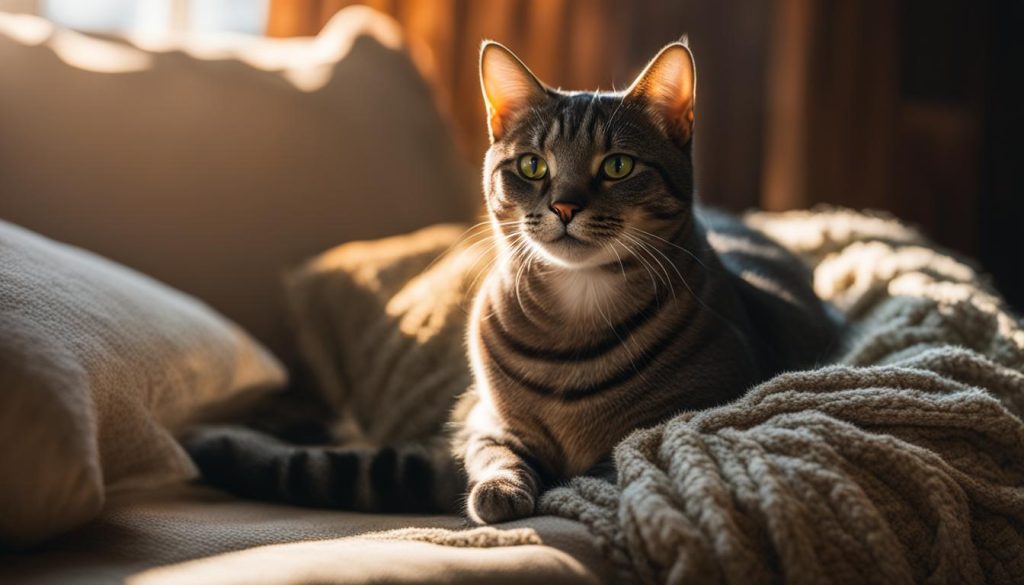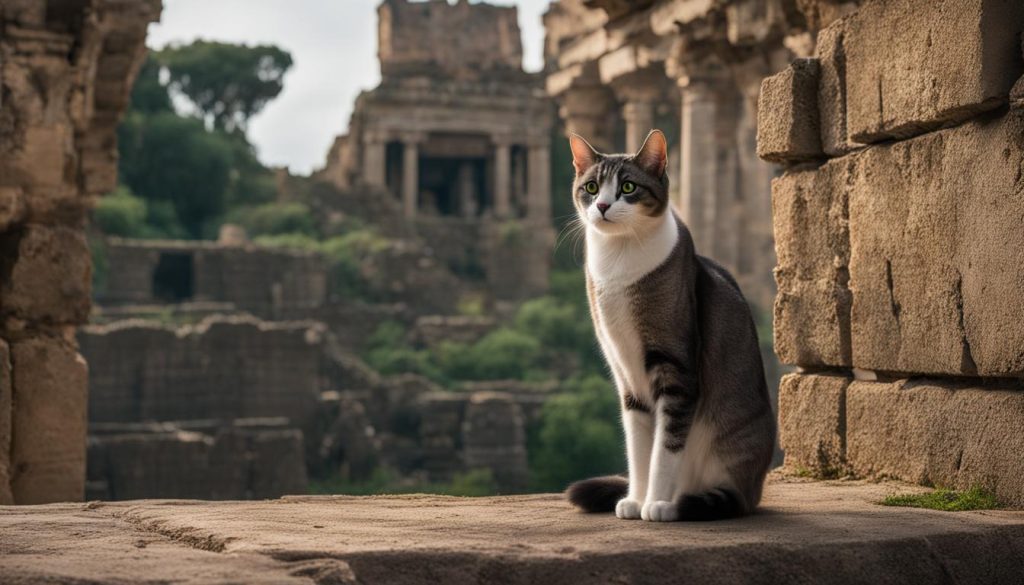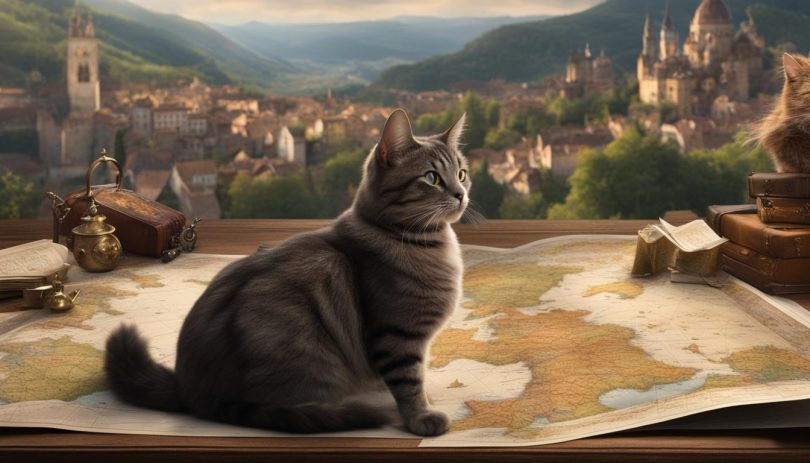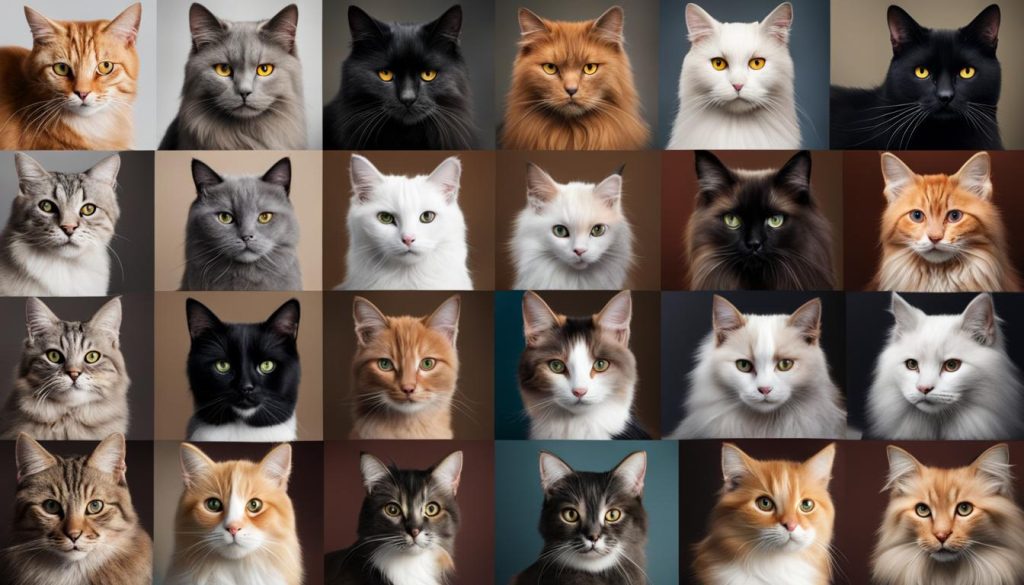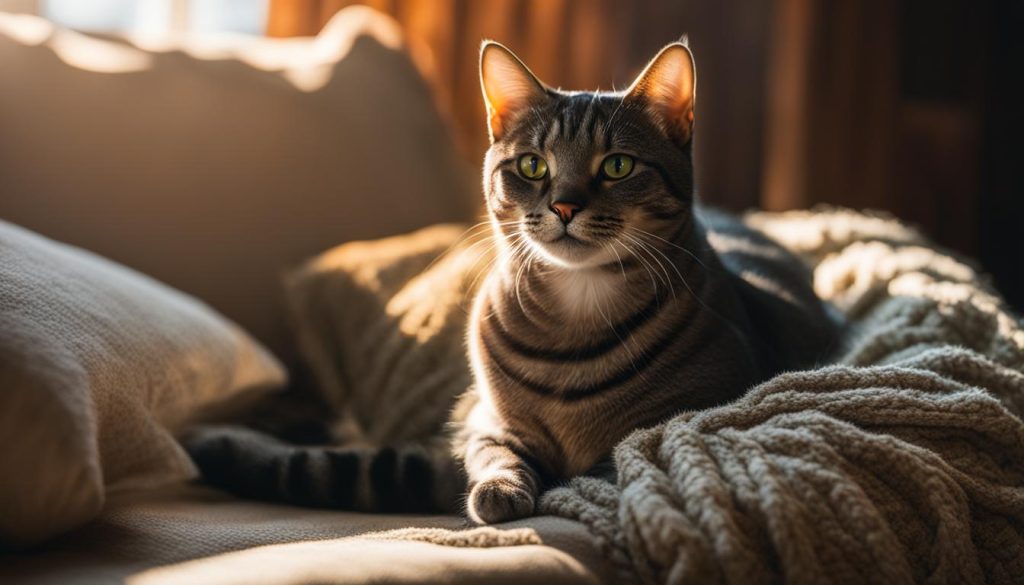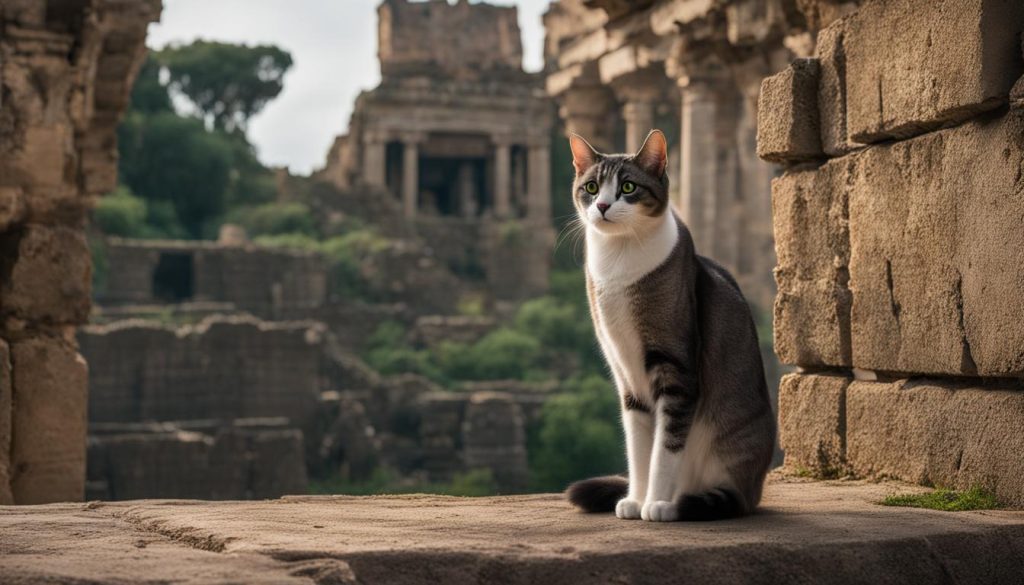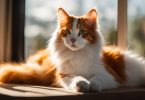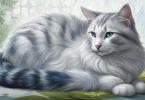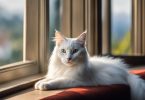Welcome to an exciting exploration of the origins and history of the enchanting European Shorthair breed. Join me as we delve into the fascinating journey of these captivating feline companions.
Key Takeaways:
- The European Shorthair breed has a diverse ancestry, encompassing various cat populations from around the world.
- European Shorthairs are the result of interbreeding between different cat populations throughout history.
- They have a well-proportioned body, expressive eyes, and alert ears.
- Domestic Shorthairs, including European Shorthairs, have a long history intertwined with human civilization.
- Selective breeding has played a significant role in shaping the characteristics of European Shorthairs.
Physical Appearance and Characteristics of European Shorthairs
The European Shorthair breed boasts a diverse array of physical appearances and characteristics, making them a popular choice for cat enthusiasts worldwide. These charming felines come in various colors, patterns, and coat lengths, displaying a unique blend of elegance and playfulness. With their well-proportioned bodies, expressive eyes, and alert ears, European Shorthairs possess a distinct charm that captivates the hearts of many.
One of the notable features of European Shorthairs is their versatility. They have a broad range of coat colors, ranging from solid shades to stunning tabby patterns. Whether you prefer a sleek black coat or a striking tortoiseshell pattern, there is a European Shorthair to suit every taste.
Furthermore, European Shorthairs are renowned for their friendly and sociable nature. They enjoy human companionship and are often seen as affectionate and playful pets. Their easy-going temperament makes them highly adaptable to different environments, making them an ideal choice for families and individuals alike.
Physical Characteristics
| Body Type | Coat Colors and Patterns | Eye Color |
|---|---|---|
| Well-proportioned | Wide range of colors and patterns | Various shades, often matching coat color |
| Muscular and agile | Solid colors, tabby patterns, tortoiseshell | |
| Expressive eyes and alert ears |
As an owner, it’s important to provide these beautiful cats with a loving and stimulating environment. Regular grooming sessions help keep their coats in top condition, whether short or medium length. Additionally, providing them with interactive toys and playtime helps satisfy their natural instincts and keeps them mentally and physically engaged.
In conclusion, European Shorthair cats possess a captivating blend of physical beauty and charming personalities. Their diverse appearances, friendly nature, and adaptability make them a beloved choice for cat lovers worldwide. Whether you’re looking for a playful companion or a loving family pet, the European Shorthair breed is sure to bring joy and happiness to your home.
Evolution from Wild Cats to Domestication
Domestic Shorthairs have a long and fascinating history intertwined with human civilization. They were initially drawn to human settlements due to the availability of food and shelter. This natural attraction led to a symbiotic relationship between cats and humans, eventually resulting in the domestication of these feline companions.
Over time, humans recognized the benefits of having cats around. Cats proved to be excellent hunters, helping to control rodent populations that plagued early agricultural communities. Their presence also brought comfort and companionship, and their ability to ward off pests made them valuable assets to human societies.
As cats began to intermingle with human populations, a process of selective breeding started to take place. Humans favored cats with certain desirable traits, such as friendly temperaments and good hunting skills. These preferred cats were more likely to survive and reproduce, passing on their favorable traits to future generations.
The Role of Selective Breeding in Domestication
Selective breeding significantly influenced the evolution of domestic shorthair cats. While not considered a specific breed with rigorous standards like purebred cats, domestic shorthairs have a diverse genetic pool.
In the words of Charles Darwin, “Selection by man is rapidly making the domestic races as distinct from each other as strongly marked as those which appear in a state of nature.”
This genetic diversity contributes to the robust health and adaptability of domestic shorthair cats. Unlike purebred cats, which often have a limited gene pool that can lead to specific health issues, domestic shorthairs benefit from a wider range of genetic variations that enhance their overall well-being.
In conclusion, the evolution from wild cats to domestication was a natural progression driven by the mutual benefits that cats and humans derived from their coexistence. The process of selective breeding further shaped the characteristics of domestic shorthair cats, resulting in their diverse and adaptable nature. Today, domestic shorthairs continue to be cherished companions for people around the world.
The Role of Selective Breeding
When it comes to the domestic shorthair breed, selective breeding has played a vital role in shaping their characteristics. Breeders have worked tirelessly to enhance desirable traits such as coat patterns, colors, and temperament. This careful selection has resulted in the diverse and captivating cats we see today.
Unlike purebred cats that have a limited gene pool, domestic shorthairs benefit from their diverse genetic makeup. This diversity contributes to their robust health and adaptability. They have a lower risk of inheriting certain genetic disorders that can affect purebred cats, making them a resilient and hardy breed.
Through selective breeding, breeders have been able to develop domestic shorthairs with various coat colors and patterns, ranging from solid colors to striking tabby and tortoiseshell patterns. Their coats can be short and sleek or long and fluffy, providing cat enthusiasts with a wide variety to choose from.
“Selective breeding has allowed us to create domestic shorthairs that not only have distinctive appearances but also possess friendly and affectionate personalities,” says Dr. Emily Collins, a renowned feline geneticist. “These cats make wonderful companions and are well-suited to different households and lifestyles.”
The Impact of Selective Breeding on Domestic Shorthair Cats
The selective breeding of domestic shorthair cats has also led to the development of specific temperament traits. Breeders have focused on breeding cats with friendly and sociable personalities, as well as cats that get along well with children and other pets. This intentional breeding has resulted in domestic shorthairs being known for their loving and adaptable nature.
Furthermore, the process of selective breeding has helped to improve the overall health of the domestic shorthair breed. Responsible breeders prioritize the health and well-being of their cats, conducting regular health screenings and genetic testing to ensure that they are breeding from healthy individuals. This commitment to breeding healthy cats has contributed to the longevity and vitality of the domestic shorthair breed.
In conclusion, selective breeding has been instrumental in shaping the domestic shorthair breed. Through careful selection and breeding practices, breeders have created cats with diverse appearances, friendly personalities, and robust health. Whether you’re looking for a cat with a specific coat pattern or a loving and adaptable companion, domestic shorthair cats are a wonderful choice.
Friendly and Affectionate Nature
European Shorthair cats are known for their friendly and affectionate nature. They have a natural affinity for human companionship and enjoy spending time with their owners. Whether curling up in their laps for a cozy cuddle or following them around the house, these cats form strong bonds and crave human interaction.
One of the reasons for their friendly nature is their long history of living alongside humans. Throughout the centuries, European Shorthairs have adapted to human society, becoming adept at reading human emotions and responding to their needs. They are intuitive and perceptive, often providing comfort and companionship during times of stress or sadness.
European Shorthair cats have a reputation for being affectionate lap cats. Their gentle purrs and affectionate nuzzles make them wonderful companions, bringing joy and warmth to their owners’ lives.
Their friendly nature also extends to other pets in the household, making them great additions to multi-pet families. They can easily get along with other cats, dogs, and even smaller animals, forging strong bonds and creating a harmonious environment.
It’s important to note that each cat has its own personality, and while European Shorthairs are generally friendly and affectionate, individual cats may exhibit different characteristics. However, their overall reputation for being loving and sociable makes them a popular choice among cat enthusiasts.
Table 6: Characteristics of European Shorthair Cats
| Characteristic | Description |
|---|---|
| Friendliness | European Shorthairs are known for their friendly and sociable nature, forming strong bonds with their human companions and other pets. |
| Affectionate | These cats thrive on human affection and enjoy being petted, cuddled, and included in daily activities. |
| Sociability | European Shorthairs are highly social cats and enjoy the company of their owners. They are often found nearby, observing and participating in household activities. |
| Adaptability | These cats can adapt well to different environments, making them suitable companions for individuals and families with varying lifestyles. |
| Playfulness | European Shorthairs have a playful nature and enjoy interactive play sessions with their owners. They can entertain themselves with toys and engage in playful antics. |
| Intelligence | These cats are intelligent and quick learners. They can easily understand and respond to human commands and cues. |
European Shorthair cats are not only beautiful and elegant but also possess a genuinely friendly and affectionate nature. Their sociable and loving disposition makes them cherished companions, providing endless joy and companionship to their owners.
Adaptability to Different Environments
European Shorthair cats are known for their exceptional adaptability, making them well-suited for various living environments. Whether they reside in a spacious home or a cozy apartment, these versatile felines have the remarkable ability to thrive and adjust to their surroundings.
The adaptability of European Shorthair cats stems from their diverse genetic background. Throughout history, cats from different populations interbred, resulting in a robust and adaptable breed. This genetic diversity has equipped European Shorthairs with the necessary traits to navigate different environments with ease.
European Shorthair cats are highly independent and can entertain themselves for hours, making them ideal companions for individuals with busy lifestyles or those who may not have ample space for a cat to roam freely. They can adapt to indoor living and are content with a stimulating environment that includes interactive toys, scratching posts, and cozy spots to curl up for a nap.
Furthermore, European Shorthair cats are known for their ability to form strong bonds with their human companions. Their friendly and sociable nature allows them to thrive in households with multiple family members or other pets. Whether they are living in a bustling city or a quiet rural area, European Shorthairs adjust well to their surroundings and quickly become valued members of the family.
| Advantages of European Shorthair Cats’ Adaptability | Challenges |
|---|---|
|
|
Overall, European Shorthair cats’ adaptability makes them versatile companions for individuals or families with different lifestyles and living arrangements. Their ability to adjust to various environments, coupled with their affectionate nature, makes them a popular choice among cat lovers.
Health and Care for European Shorthair Cats
Ensuring the health and well-being of European Shorthair cats is essential for their longevity and happiness. By providing proper care and attention, you can help your feline companion thrive. Here are some key aspects to consider:
Nutritious Diet:
A well-balanced and nutritious diet is crucial for maintaining your European Shorthair cat’s overall health. Consult with a veterinarian to determine the best food options based on your cat’s age, weight, and specific nutritional needs. Feed them high-quality cat food that includes a mix of protein, fats, and carbohydrates.
Regular Veterinary Check-ups:
Schedule regular check-ups with a trusted veterinarian to monitor your European Shorthair cat’s health and catch any potential issues early on. The vet can provide vaccinations, perform necessary tests, and offer advice on preventive care. Regular dental check-ups are also important for maintaining good oral hygiene.
Stimulating Environment:
Creating a stimulating environment is crucial for your European Shorthair cat’s well-being. Provide them with scratching posts, toys, and climbing structures to keep them mentally and physically engaged. Interactive playtime and regular exercise help prevent boredom and ensure they maintain a healthy weight.
| Health and Care Tips | Description |
|---|---|
| Grooming | Regular grooming sessions help keep your European Shorthair cat’s coat healthy and reduce the risk of hairballs. Brush their fur to remove loose hair and prevent matting. Additionally, trim their nails regularly to maintain proper nail length. |
| Hydration | Ensure your cat has access to fresh water at all times to prevent dehydration. Consider providing a water fountain to encourage drinking. Wet cat food can also help increase their water intake. |
| Safe Environment | Make your home safe for your European Shorthair cat by removing any poisonous plants or hazardous substances. Keep electrical cords out of reach and secure windows to prevent accidents. Provide a comfortable space for them to relax, away from any potential stressors. |
By prioritizing the health and care of your European Shorthair cat, you can ensure they live a happy and fulfilling life by your side.
Conclusion
In conclusion, the European Shorthair breed has an intriguing origin deeply rooted in feline history. Through the interbreeding of various cat populations, including the European wildcat and cats from different parts of the world, this unique breed has emerged.
The European Shorthair cats possess a wide range of physical attributes, including different colors, patterns, and coat lengths, which contribute to their distinct appearance. Their friendly and affectionate nature, coupled with their adaptability to different environments, make them cherished companions for individuals and families.
With a long history intertwined with human civilization, European Shorthair cats have become beloved pets worldwide. Whether you’re seeking a playful and energetic companion or a loving family pet, these cats are an excellent choice due to their charming personalities and unique characteristics.
FAQ
What is the origin of the European Shorthair breed?
The European Shorthair breed has a rich and diverse ancestry, descending from various cat populations around the world, including the European wildcat, Egyptian cats, and cats brought by explorers and traders. Over time, these different cat populations interbred, resulting in the unique breed we know today.
What are the physical appearance and characteristics of European Shorthairs?
European Shorthair cats come in a variety of colors, patterns, and coat lengths. They have a well-proportioned body, expressive eyes, and alert ears. Their diverse appearances and friendly nature make them beloved pets and valued members of many households.
How did domestic shorthair cats become domesticated?
Domestic Shorthairs have a long history intertwined with human civilization. They were initially drawn to human settlements due to the availability of food and shelter. Over time, humans recognized the benefits of having cats around, and these cats became domesticated and integrated into human society.
What role did selective breeding play in domestic shorthair cats?
Selective breeding played a significant role in shaping the characteristics of domestic shorthairs. Breeders sought to enhance desirable traits such as coat patterns, colors, and temperament. However, unlike purebred cats, domestic shorthairs have a diverse genetic pool, which contributes to their robust health and adaptability.
Are there recognized breed standards for domestic shorthair cats?
While domestic shorthair cats do not adhere to specific breed standards like purebred cats, they do have certain general characteristics. These include a strong and agile body, a broad range of coat colors and patterns, and a friendly and affectionate nature.
What is the friendly and affectionate nature of European Shorthair cats?
European shorthair cats are known for their friendly and affectionate nature. They form strong bonds with their human companions and enjoy being in their company. Their playful antics and purrs make them wonderful companions for individuals and families alike.
Are European Shorthair cats adaptable to different environments?
European Shorthair cats are adaptable to different environments. Whether they live in a spacious home or a cozy apartment, they can thrive and adjust well. Their versatile nature makes them suitable companions for individuals or families with diverse lifestyles.
How should I care for the health of my European Shorthair cat?
Providing a well-balanced and nutritious diet, regular veterinary check-ups, and a stimulating environment are crucial for the health and well-being of European Shorthair cats. Additionally, regular grooming and exercise help keep them happy and in optimal condition.
